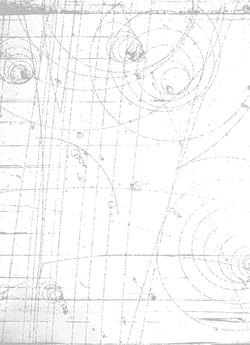

The first omega-
One of the most famous bubble chamber pictures of all – this shows the
discovery of the ![]() in the Brookhaven National Laboratory 80 inch hydrogen bubble chamber in 1964.
in the Brookhaven National Laboratory 80 inch hydrogen bubble chamber in 1964.
Although the tracks are rather faint, this is a picture with enough characteristic
signatures (click here for tutorial step 7) for a clear identification of the
![]() without any need for measurement.
without any need for measurement.
The knock-on electron in the bottom left of the picture shows that negative particles turn to the right. The event of interest, which is near this electron, has two outgoing charged tracks, one of which has a significant kink. The next question to ask is, 'Is there a vee pointing to this kink?’ There is a clear candidate but it does not point to the kink or the primary interaction. (You can check this easily by printing off the event and then continuing the curves of the vee until they meet; then, with a ruler, follow back the line joining the point where the vee tracks cross to the vee decay point – it misses both the kink and the primary vertex.)
So where does the vee come from? The picture provides a clue:
near the middle on the right hand side a photon ![]() has
'materialised’ into
an
has
'materialised’ into
an ![]()
![]() pair
in the field of a nucleus. This photon
pair
in the field of a nucleus. This photon ![]() ,
like the vee, does not point to the kink
or the primary vertex but crosses the event downstream of these. Finally, near
the top left of the picture, a second photon
,
like the vee, does not point to the kink
or the primary vertex but crosses the event downstream of these. Finally, near
the top left of the picture, a second photon ![]() 'materialises’.
These signatures are what one would expect if the
'materialises’.
These signatures are what one would expect if the ![]() had
decayed into
had
decayed into ![]()
![]() ,
with subsequent decay of the
,
with subsequent decay of the ![]() to
to
![]()
![]() .
For the signatures click here.
.
For the signatures click here.
(The materialisation of both gammas ![]()
![]() from
a
from
a ![]() in hydrogen is exceedingly rare. The unique identification of this event by
inspection, without measurements,
was good enough for the physicist concerned to enjoy the pleasure of waking
up
the director of his laboratory in the middle of the night!)
in hydrogen is exceedingly rare. The unique identification of this event by
inspection, without measurements,
was good enough for the physicist concerned to enjoy the pleasure of waking
up
the director of his laboratory in the middle of the night!)
For the original paper, click here. For some EXCEL calculations of masses,
Click
here.